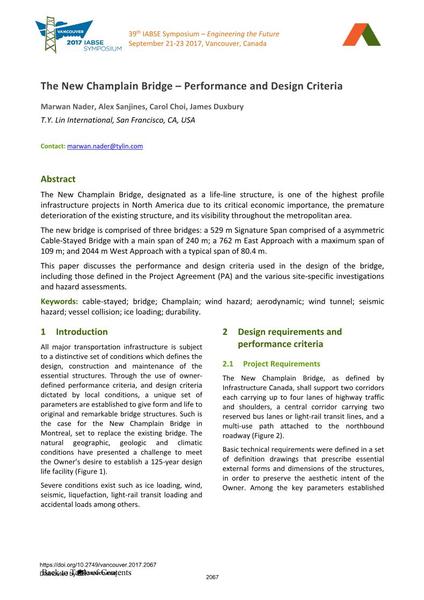The New Champlain Bridge – Performance and Design Criteria

|
|
|||||||||||
Détails bibliographiques
| Auteur(s): |
Marwan Nader
(T.Y. Lin International, San Francisco, CA, USA)
Alex Sanjines (T.Y. Lin International, San Francisco, CA, USA) Carol Choi (T.Y. Lin International, San Francisco, CA, USA) James Duxbury (T.Y. Lin International, San Francisco, CA, USA) |
||||
|---|---|---|---|---|---|
| Médium: | papier de conférence | ||||
| Langue(s): | anglais | ||||
| Conférence: | IABSE Symposium: Engineering the Future, Vancouver, Canada, 21-23 September 2017 | ||||
| Publié dans: | IABSE Symposium Vancouver 2017 | ||||
|
|||||
| Page(s): | 2067-2074 | ||||
| Nombre total de pages (du PDF): | 8 | ||||
| Année: | 2017 | ||||
| DOI: | 10.2749/vancouver.2017.2067 | ||||
| Abstrait: |
The New Champlain Bridge, designated as a life-line structure, is one of the highest profile infrastructure projects in North America due to its critical economic importance, the premature deterioration of the existing structure, and its visibility throughout the metropolitan area. The new bridge is comprised of three bridges: a 529 m Signature Span comprised of a asymmetric Cable-Stayed Bridge with a main span of 240 m; a 762 m East Approach with a maximum span of 109 m; and 2044 m West Approach with a typical span of 80.4 m. This paper discusses the performance and design criteria used in the design of the bridge, including those defined in the Project Agreement (PA) and the various site-specific investigations and hazard assessments. |
||||
| Mots-clé: |
pont soufflerie
|
||||
